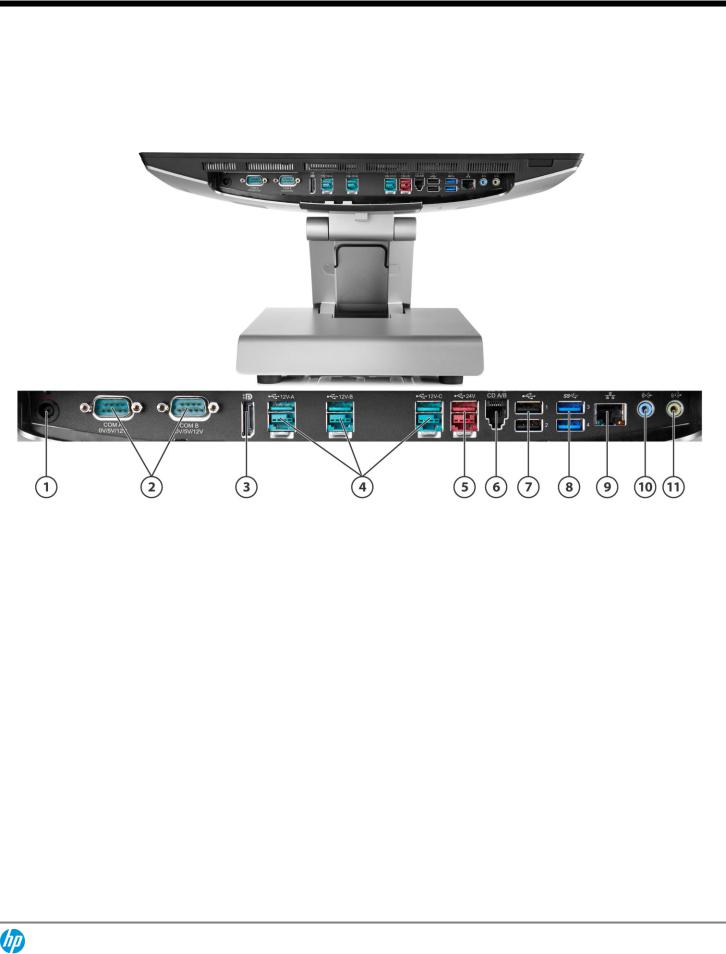HP RP9 9115 G1 User Manual

QuickSpecs
HP RP9 G1 Retail System
Overview
HP RP9 G1 Retail System, Models 9015, 9018, 9115 & 9118
FRONT VIEW
1. |
Optional HP Retail Integrated Webcam |
5. |
Compact Stand with pass through cable cover |
2. |
Optional HP Retail Integrated Integrated Single-Head MSR |
6. |
Touchscreen Assembly |
3. |
On-screen display LED's |
7. |
Optional HP Retail Integrated Barcode Scanner |
4 |
Recessed Power button |
|
|
c04917355 — DA – 15371— Worldwide — Version 11 — January 14, 2018 |
Page 1 |

QuickSpecs
HP RP9 G1 Retail System
Overview
REAR VIEW with HP 2x20 Display (Bottom Mount option)
1.Dual Integrated Speakers (Left and right)
2.HP RP9 Integrated 2x20 Display (bottom mount) with extension arm (Optional)
c04917355 — DA – 15371— Worldwide — Version 11 — January 14, 2018 |
Page 2 |

QuickSpecs
HP RP9 G1 Retail System
Overview
HP RP9 G1 Retail System
I/O panel
|
|
Image shown with ergonomic stand |
|
1. |
DC in power port |
7. |
USB 2.0 ports (2) |
2. |
COM/serial ports (2) |
8. |
USB 3.0 ports (2) |
3. |
DisplayPort 1.2 (1) |
9. |
Ethernet port 10/100/1000 |
4. |
12V Powered USB ports (3) |
10. |
Audio line-in |
5. |
24V Powered USB ports (1) |
11. |
Audio line-out |
6.Cash Drawer port (1)
c04917355 — DA – 15371— Worldwide — Version 11 — January 14, 2018 |
Page 3 |

QuickSpecs
HP RP9 G1 Retail System
Overview
At A Glance
Long lifecycle performance All-in-One (AiO) Retail System for retail and hospitality markets Choice of operator display: o 15.6" Diagonal, wide aspect (16:9), projected capacitive touchscreen (1366 x 768 HD resolution) Anti-Glare
o 18.5" Diagonal, wide aspect (16:9), projected capacitive touchscreen (1366 x 768 HD resolution) Anti-Glare
Processor choices:
Models 9015 & 9018
o Intel® Core™ i7-6700 with vPro™ (3.4GHz, 8M Cache, 4 Cores) o Intel® Core™ i5-6500 with vPro™ (3.2GHz, 6M Cache, 4 Cores) o Intel® Core™ i5-6500TE with vPro™ (2.3GHz, 6M Cache, 4 Cores) o Intel® Core™ i3-6100 (3.7GHz, 3M Cache, 2 Cores)
o Intel® Pentium® G4400 (3.3GHz, 3M Cache, 2 Cores)
o Intel® Celeron® G3900 (2.8GHz, 2M Cache, 2 Cores)
Models 9115 & 9118
o Intel® Core™ i7-7700 with vPro™ (8M Cache, 3.6 GHz, , 4 cores) o Intel® Core™ i5-7600 with vPro™ (6M Cache, 3.5 GHz, 4 cores) o Intel® Core™ i3-7101E (3M Cache, 3.90 GHz, 2 cores)
oIntel® Celeron® Processor G3930E (2M Cache, 2.90 GHz, 2 cores )
Operating System choices:
Models 9015 & 9018
o Windows Embedded Industry 8.1 Pro Retail 64-bit o POSReady 7 32-bit
o POSReady 7 64-bit
o Windows 10 IoT Enterprise 2016 LTSB o Windows 10 Pro 64-bit
o Windows 7 Professional 32-bit (Available through downgrade rights from Windows 10 Pro) o Windows 7 Professional 64-bit (Available through downgrade rights from Windows 10 Pro) o FreeDOS 2.0
Models 9115 & 9118
o Windows 10 IoT Enterprise 2016 LTSB o Windows 10 Pro 64-bit
oFreeDOS 2.0
Integrated peripheral options (can also be purchased and installed separately): o HP Retail Integrated MSR - Encryption – Capable
o HP Retail Integrated Fingerprint Reader o HP Retail Integrated Webcam
o HP Retail Integrated Barcode Scanner, side mount and bottom mount options
o Customer-facing 2 line LED Display (2x20); supports complex and non-complex characters o Customer-facing 7" Diagonal non-Touch LCD Display
Industry-standard 100mm VESA mounting pattern allows for flexible use without the optional stand (Mounting hardware sold separately)
Choice of Compact stand, Ergonomic stand or no stand (display – head unit only)
(2) Two DDR4 Memory Slots (32 GB Maximum)
Intel Ethernet Connection I219-LM
Trusted Platform Module (TPM 1.2)
HP BIOSphere with HP Sure Start technology
(2) Two M.2 drive bays, and (1) one 2.5” drive bay for Hard Drive and Solid-State Drive Options
RAID level 0,1 capable
Cable Management Features
c04917355 — DA – 15371— Worldwide — Version 11 — January 14, 2018 |
Page 4 |

QuickSpecs
HP RP9 G1 Retail System
Overview
ENERGY STAR® certified, EU Compliant, RoHS2 Compliant, EPEAT® Gold
230 W, up to 89% efficient, active PFC power supply (enclosed in stand on Ergonomic stand, external with Compact stand)
HP Limited Warranty, 3/3/3 standard: 3 years parts, 3 years labor, and 3 years on-site services
NOTE: See important legal disclosures for all listed specs in their respective features sections.
c04917355 — DA – 15371— Worldwide — Version 11 — January 14, 2018 |
Page 5 |

QuickSpecs
HP RP9 G1 Retail System
Standard and Configurable Components
OPERATING SYSTEM
Preinstalled
Windows Embedded 8.1 Industry Pro Retail 64-bit**** POSReady 7 32-bit****
POSReady 7 64-bit****
Windows 10 IoT Enterprise 2016 LTSB* Windows 10 Pro 64-bit*, ****
Windows 7 Professional 32-bit (Available through downgrade rights from Windows 10 Pro)**,**** Windows 7 Professional 64-bit (Available through downgrade rights from Windows 10 Pro)**, ****
FreeDOS 2.0
Supported Ubuntu
Certified |
SUSE Linux Enterprise Desktop YES Certified1 |
*Not all features are available in all editions or versions of Windows. Systems may require upgraded and/or separately purchased hardware, drivers, software or BIOS update to take full advantage of Windows functionality. Windows 10 is automatically updated, which is always enabled. ISP fees may apply and additional requirements may apply over time for updates. See http://www.microsoft.com
**This system is preinstalled with Windows 7 Professional software and also comes with a license and media for Windows 10 Pro software. You may only use one version of the Windows software at a time. Switching between versions will require you to uninstall one version and install the other version. You must back up all data (files, photos, etc.) before uninstalling and installing operating systems to avoid loss of your data. See http://www.microsoft.com
***This system is preinstalled with Windows 8.1 Pro software and also comes with a license and media for Windows 10 Pro software. You may only use one version of the Windows software at a time. Switching between versions will require you to uninstall one version and install the other version. You must back up all data (files, photos, etc.) before uninstalling and installing operating systems to avoid loss of your data. See http://www.microsoft.com
****In accordance with Microsoft’s support policy, HP does not support the Windows 8 or Windows 7 operating
system on products configured with Intel® 7th generation and forward processors or provide any Windows 8 or Windows 7 drivers on http://www.support.hp.com
Note 1: Certification in late 2016.
The following features are not supported by Novell SUSE Linux Enterprise Desktop:
HP ProtectTools (Available with Windows 7 only)
Power Management features
Multi-touch capabilities
Systems configured with Linux do not qualify for ENERGY STAR
PROCESSORS
Models 9015 & 9018
Intel® Core™ i7-6700 with vPro (3.4GHz, 8M Cache, 4 Cores)*
Intel® Core™ i5-6500 with vPro (3.2GHz, 6M Cache, 4 Cores)
Intel® Core™ i5-6500TE with vPro (2.3GHz, 6M Cache, 4 Cores)
Intel® Core™ i3-6100 (3.7GHz, 3M Cache, 2 Cores)*
c04917355 — DA – 15371— Worldwide — Version 11 — January 14, 2018 |
Page 6 |

QuickSpecs
HP RP9 G1 Retail System
Standard and Configurable Components
Intel® Pentium® G4400 (3.3GHz, 3M Cache, 2 Cores)
Intel® Celeron® G3900 (2.8GHz, 2M Cache, 2 Cores)
Models 9115 & 9118
Intel® Core™ i7-7700 with vPro™ (8M Cache, 3.6 GHz, , 4 cores)
Intel® Core™ i5-7600 with vPro™ (6M Cache, 3.5 GHz, 4 cores)
Intel® Core™ i3-7101E (3M Cache, 3.90 GHz, 2 cores)
Intel® Celeron® Processor G3930E (2M Cache, 2.90 GHz, 2 cores )
NOTE: Core™ i5 and Core™ i7 Turbo Boost technology – performance can be increased through the BIOS
c04917355 — DA – 15371— Worldwide — Version 11 — January 14, 2018 |
Page 7 |

QuickSpecs
HP RP9 G1 Retail System
Standard and Configurable Components
CORE™ vPRO™ PROCESSORS
INTEL® 6th GENERATION CORE™ vPRO™ PROCESSORS
The HP RP9 Retail System features this technology, and includes processors that are part of the Intel® Stable Image. Platform Program (SIPP) designed to ensure the stability promise inherent in the value proposition of the HP RP9 Retail System, thus making these models the most stable, secure, and manageable platforms available to retailers today.
INTEL® 7th GENERATION CORE™ vPRO™ PROCESSORS
The HP ElitePOS Retail System features this technology, and includes processors that are part of the Intel® Stable Image. Platform Program (SIPP) designed to ensure the stability promise inherent in the value proposition of the HP ElitePOS Retail System. This makes these models the most stable, secure, and manageable platforms available to retailers today.
CHIPSET
Intel® Q170 Chipset (Models 9015 & 9018) Intel® Multi-Chip Package – MCP (Models 9115 & 9118)
c04917355 — DA – 15371— Worldwide — Version 11 — January 14, 2018 |
Page 8 |

QuickSpecs
HP RP9 G1 Retail System
Standard and Configurable Components
HP BIOS
Key features of the HP BIOS include:
Deployment and manageability – HP BIOS provides several technologies that help integrate the HP RP9 G1 Retail System into a business environment, such as PXE, remote configuration, remote control, and F10 Setup support for 12 languages.
Update your BIOS via the cloud or standardize on a BIOS version hosted on Enterprise network.
Select models feature either Intel® Standard Manageability or Intel® Core™ vPro™ Processor Technology.
Stability – HP BIOS supports the HP stable product roadmap by releasing only critical BIOS changes to the factory and advanced change notification.
UEFI specification 2.1
Absolute Persistence agent – For tracking and tracing services, available in select countries, separate software and purchase of a subscription is required.
Thermal and power management – The HP BIOS provides and enables thermal and power management technologies so component temperatures are managed for high reliability and to assist in operating the RP9 1 Retail System in any retail environment.
Acoustic performance – Industry leading acoustic emissions across the range of operating conditions.
Serviceability – HP BIOS provides diagnostic and detailed service information.
Upgrades and recovery – HP BIOS provides numerous ways to upgrade the HP RP9, including BIOS updates from within DOS (DOSFlash), BIOS updates from within Windows (HPQFlash), HP Client Manager, and fail-safe recovery. In addition, the HP RP9 BIOS Utilities tool enables replicated BIOS setup throughout the Enterprise; it is available from within the BIOS software and from the support website.
HP BIOS uses PKI signing of the BIOS for trusted BIOS upgrades and recovery.
Additional HP BIOS Features:
Power-On password – Helps prevent an unauthorized user from powering on the system.
Administrator password – Also known as the setup password, this helps prevent unauthorized changes to the system configuration. If the administrator password is not known, the BIOS version cannot be changed and changes cannot be made to BIOS settings using F10 setup or under the OS.
Advanced Configuration and Power Interface (ACPI) – Represents a significant innovation in power and configuration management, allowing operating systems and applications to manage power based on activity and usage. The HP RP9 G1 Retail System uses ACPI to provide power conservation features.
S5 Max Power Savings setting supports EU Lot6 requirement and allows the computer to power down below 1W is S5 (when turned off). When S5 Max Power Savings feature is enabled power to slots is turned off along with WOL functionality.
NOTE: Models 9015 & 9018 will have BIOS Family N30 vx.xx Models 9115 & 9118 will have BIOS Family P35 vx.xx
Sure Start
BIOS Integrity checking – Sure Start protection ensures that only trusted BIOS code is executed and not rootkits, viruses and malware. Verification is done upon boot up, shutdown and while on.
Sure Start is set by default to automatically repair the BIOS if corrupted or compromised but is policy driven for better manageability.
Protecting beyond BIOS – Integrity checking and repair is extended to other data that should be protected such as network configuration parameters (network name), platform specific information (i.e. system IDs) and other code the system needs to boot.
Audit enabled – System Audit via Sure Start Event Logs capture data such as incident, repair date and time for troubleshooting and investigating.
Touch-down and lift-off, individual disable of BIOS
Security
HP RP9 Biometric Fingerprint reader (optional)
HP BIOSphere with Sure Start
c04917355 — DA – 15371— Worldwide — Version 11 — January 14, 2018 |
Page 9 |

QuickSpecs
HP RP9 G1 Retail System
Standard and Configurable Components
Security lock slot
Serial, USB enable/disable (via BIOS)
Power-on password (via BIOS)
Setup password (via BIOS)
Automatic Drive Lock
Secure erase (via BIOS)
Device Guard (via BIOS)
c04917355 — DA – 15371— Worldwide — Version 11 — January 14, 2018 |
Page 10 |

QuickSpecs
HP RP9 G1 Retail System
Standard and Configurable Components
SOFTWARE
HP Client Management Solutions (available for free download from hp.com/go/easydeploy)
HP SoftPaq Download Manager
HP Client Catalog for Microsoft SMS
HP Systems Software Manager
HP Client Automation Starter
GRAPHICS
Intel® HD Graphics (integrated)
Integrated graphics |
Intel Integrated HD Graphics 510 (Celeron & Pentium, Models 9015/9018); Intel Integrated HD |
||
|
Graphics 530 (Core i3, Core i5, Core i7, Models 9015/9018); Intel Integrated HD Graphics 610 |
||
|
(Celeron, Models 9115/9118), Intel Integrated HD Graphics 630 (Core i3, Core i5, Core i7, |
||
|
Models 9115/9118) |
|
|
DisplayPort |
Multimode capable; supports HDCP, Display Port Audio (2 streams), HBR2 link rates and Multi- |
||
|
Stream Technology for a maximum of 3 displays (including the integrated panel) |
||
Memory |
The BIOS has options for selecting the dedicated memory size of 128MB, 256MB or 512MB |
||
|
Additional memory is allocated for graphics as needed using Intel's Dynamic Video Memory |
||
|
Technology (DVMT), to provide an optimal balance between graphics and system memory use. |
||
Maximum Graphics Memory |
Microsoft Windows 7 |
Windows 8.1 |
Windows 10 |
|
Up to 1.7GB |
Up to 1.8GB |
>4 GB |
Maximum Color Depth
Graphics/Video API Support
Note: the actual amount of maximum graphics memory can be less than the amounts listed above depending upon your computer’s configuration.
32 bits/pixel
6th & 7th Generation Core™ processors:
Next Generation Intel® Clear Video Technology HD Support is a collection of video playback and enhancement features that improve the end user's viewing experience
o Encode/transcode HD content
o Playback of high definition content including Blu-ray Disc o Superior image quality with sharper, more colorful images
DirectX Video Acceleration (DXVA) support for accelerating video processing
oFull AVC/VC1/MPEG2/HEVC HW Decode
Advanced Scheduler 2.0, 1.0
Windows 7, Windows 8.1, Windows 10, Linux OS Support
DirectX 12.1
OpenGL 4.4
Open CL 1.2 (Intel® HD Graphics 510)
Open CL 1.2/2.0 (Intel® HD Graphics 530)
c04917355 — DA – 15371— Worldwide — Version 11 — January 14, 2018 |
Page 11 |

QuickSpecs
HP RP9 G1 Retail System
Standard and Configurable Components
Supported Display Resolutions and Refresh Rates
Note: Other resolutions may be available but are not recommended as they may not have been tested and qualified by HP
Resolution |
Refresh Rates |
800x600 |
60 Hz |
1024x768 |
60 Hz |
1152x864* |
60 Hz |
1280x600 |
60 Hz |
1280x720 |
60 Hz |
1280x800* |
60 Hz |
1280x960* |
60 Hz |
1280x1024* |
60 Hz |
1360x768 |
60 Hz |
1366x768 |
60 Hz |
1400x1050* |
60 Hz |
1440x900* |
60 Hz |
1600x900* |
60 Hz |
1600x1200* |
60 Hz |
1680x1050* |
60 Hz |
1920x1080* |
60 Hz |
1920x1200* |
60 Hz |
1920x1440* |
60 Hz |
2560x1440* |
60 Hz |
2560x1600* |
60 Hz |
3840x2160** |
60 Hz |
*Only supported on displays connected to the external DisplayPort connector.
**3840x2160 is not supported for Pentium and Celeron series processors
c04917355 — DA – 15371— Worldwide — Version 11 — January 14, 2018 |
Page 12 |

QuickSpecs
HP RP9 G1 Retail System
Standard and Configurable Components
MEMORY
Type
DDR4-2133 & DDR4-2400 Memory DIMMs, Transfer rates up to 2400 MT/s
Maximum
32 GB
# of Slots
2 SODIMM
Memory Upgrades
Both slots are customer accessible / upgradeable.
4,096 MB (4096 MB x 1)
8,192 MB (4096 MB x 2)
8,192 MB (8192 MB x 1)
16,384 MB (8192 MB x 2)
32,768 (16,384 MB x 2)
Key Benefits of DDR4 Memory:
Dual channel configuration – HP RP9 features motherboards designed with two memory channels instead of a single channel.
Reduce system latencies and significantly improve your system performance with dual channel memory configurations by utilizing the theoretical bandwidth of two memory modules instead of one.
Expect fast start-up times with reduced delays during routine operations and system maintenance functions. Meet everyday workloads head on, and run more programs simultaneously. Easily toggle back and forth between several open applications with noticeable speed.
NOTE: For systems configured with more than 3 GB of memory and a 32-bit operating system, all memory may not be available due to system resource requirements. Addressing memory above 4 GB requires a 64-bit operating system.
Memory modules support data transfer rates up to 2133 MT/s; actual data rate is determined by the system's configured processor. See processor specifications for supported memory data rate.
CAUTION: You must shut down the Retail System and disconnect the power cord before adding or removing memory modules. Regardless of the power-on state, voltage is always supplied to the memory modules as long as the Retail System is plugged in to an active AC outlet. Adding or removing memory modules while voltage is present may cause irreparable damage to the memory modules or system board.
c04917355 — DA – 15371— Worldwide — Version 11 — January 14, 2018 |
Page 13 |

QuickSpecs
HP RP9 G1 Retail System
Standard and Configurable Components
HARD DISK AND SOLID STATE STORAGE
Drive Bays
3 (three) Storage Bays:
1 (one) 2.5” HDD/SSD Bay
SATA
2 (two) M.2 SSD Bays
SATA
PCIe (AHCI)
PCIe (NVME)
Options:
2.5” Drives
64GB SATA SSD
128GB SATA 2.5 3D SSD
HP 128GB SATA TLC 2.5” SSD Drive 128GB SATA 2.5 Opal2 SED SSD 1TB SATA 6G 2.5 8G SSHD
256GB SATA 2.5 3D SSD
HP 256GB SATA TLC 2.5” SD Drive
500GB 7200 RPM SATA 2.5 HDD 500GB 7200 RPM SATA 2.5 SED HDD 256GB SATA 2.5 Opal2 TLC SED SSD 512GB SATA 3D Solid State Drive
M.2 Storage:
M.2 SATA
128GB M.2 SATA 3D SSD
256GB M.2 SATA 3D SSD
NVMe
128GB Turbo Drive G2 SSD- M.2 PCIe
256GB Turbo Drive G2 SSD- M.2 PCIe
256GB Turbo Drive G2 TLC SSD - M.2 PCIe
128GB Turbo Drive G2 TLC SSD - M.2 PCIe
c04917355 — DA – 15371— Worldwide — Version 11 — January 14, 2018 |
Page 14 |

QuickSpecs
HP RP9 G1 Retail System
Standard and Configurable Components
OPERATOR DISPLAY
15.6" Diagonal Wide-Aspect Operator Display
Touch Technology |
Projected Capacitive Touchscreen |
Resolution |
1366 x 768 Resolution |
Aspect Ratio |
16:9 |
Max Color |
16.7M |
Contrast Ratio |
Typical 500:1 |
Pixel Pitch |
252um |
Viewing Angle |
Horizontal 1700, Vertical 1600 |
Response rate |
8ms (Typical On/Off) |
Backlight |
LED |
Operating Temperature range |
0 to 600C (+ 600C as panel surface temperature) |
18.5" Diagonal Wide Aspect Projective Capacitive Operator Display |
|
Touch Technology |
Projected Capacitive Touchscreen |
Resolution |
1366 x 768 |
Aspect Ratio |
16:9 |
Max Color |
16.7M |
Contrast Ratio |
Typical 1000 |
Pixel Pitch |
300um |
Viewing Angle |
Horizontal 1700, Vertical 1600 |
Response rate |
5ms (Typical On / Off) |
Backlight |
LED |
Operating Temperature range |
0 to 600C (+ 600C as panel surface temperature) |
|
|
c04917355 — DA – 15371— Worldwide — Version 11 — January 14, 2018 |
Page 15 |

QuickSpecs
HP RP9 G1 Retail System
Technical Specifications - Audio
High Definition Audio*
Type
HD Stereo Codec
Audio I/O Ports
Internal Speaker Amplifier
Sampling Analog Audio
# of Channels on Line-Out Internal Speaker External Speaker Jack
Integrated
Conexant CX5001 Audio codec. Side Headphone/Line out
Side Microphone/Line-In All ports are 3.5mm
2.2W amplifier for the internal speaker only. External speakers must be powered externally.
44.1 kHz - 192 kHz Yes
Stereo (Left & Right channels) Yes
Yes
Conexant CX5001 Audio codec.
Integrated high-performance 2x2.2W internal speakers, stereo headphone jack re-taskable for line-out, microphone jack-in, re-taskable for line-in.
NOTE: Audio input ports are re-taskable as a Line-in or Microphone-in port. External speakers must be powered externally. Multi-streaming can be enabled to allow independent audio streams to be sent to/from the internal speakers and headphone/Line out jack. This allows for different audio applications to use separate audio ports on the system. For example, the Headphone jack could be used with a headphone for a communications application while the internal speakers for a multimedia application.
c04917355 — DA – 15371— Worldwide — Version 11 — January 14, 2018 |
Page 16 |

QuickSpecs
HP RP9 G1 Retail System
Technical Specifications – Storage
Introduction:
HP Serial Advanced Technology Attachment (SATA) Hard Drives maximize the performance by providing the technologies to meet your increasing storage demands with high-capacity drives offering superior reliability and performance.
SATA provides faster data transfer speeds, better system cooling airflow, more bandwidth, more headroom for speed increases in future generations and better data integrity. A next-generation technology, the SATA interface connects hard drives to the Platform, enabling easy aggregation of multiple hard drives into a single Retail Point of Sale system. This offers you the additional benefits of dedicated bandwidth, the ability to more easily identify device failures and scalability. The HP RP9 G1 Retail System supports the latest SATA 6.0Gb/s specification.
HP Drive Lock
HP Serial ATA Hard Drives offer enhanced security via a new Drive Lock. When enabled, this ATA security feature set prevents software access to user data on the drive until one or two user-defined passwords are provided.
SMART IV Technology
Self-Monitoring Analysis and Reporting Technology (SMART) hard drive technology allows hard drives to monitor their own health and to raise flags if imminent failures are predicted. If the drive determines that a failure is imminent, the SMART hard drive technology enables the intelligent manageability or management software to generate a fault alert. While the current versions of SMART hard drives do a good job monitoring the data on the hard drive media, the ever increasing emphasis on reliability and quality has promoted HP to implement SMART IV technology which constantly checks that the data flow from host interface to media and media to host interface is not compromised. This is accomplished by inserting a 2 byte parity code into every 512 byte block in the data path of the hard drive's Cache RAM. This unique parity checking performed by HP's SMART IV technology hard drives, allows for more complete error detection coverage encompassing the entire data path between the host and the hard drive.
Smart IV is also known as IOEDC: I/O Error Detection Code.
Native Command Queuing
NCQ or Native Command Queuing is a SATA protocol extension that allows the hard drive to have several write or read commands outstanding at the same time. In contrast, normal non-queued operation requires each command to be completed before the next command is issued by the host system. Queuing allows the drive to complete the commands in the order that allows for best overall throughput. It also involves an advanced method of transferring data to or from the host, called First Party Direct Memory Access (FPDMA), which allows the hard drive and the host controller to manage the data transfers for multiple outstanding commands, without involving the host processor. NCQ can contribute to better performance but the results are dependent on many factors, including the access patterns of the various applications and operating system functions that are initiating drive accesses. Enabling NCQ features in the hard drive requires AHCI support from the host system BIOS, controller, and driver. AHCI support is typically implemented in RAID configurations.
Note: GB = 1 billion bytes. Actual available capacity is less.
Redundant Array of Independent Drives (RAID)
Flexible implementation:
DriveLock is supported while in RAID mode. Users can manage the DriveLock password from within F10 Setup. Locked drives will be displayed as such in the RAID option ROM interface.
Hard drive information can be viewed within F10 Setup while in RAID mode. Previously, the hard drives will not appear in Drive Configuration when switching to RAID mode.
DPS Self-Test can be executed on physical hard drives while in RAID mode.
The RAID Setup Utility (accessed through CTRL-I) can be protected by the F10 Setup password.
•
c04917355 — DA – 15371— Worldwide — Version 11 — January 14, 2018 |
Page 17 |

QuickSpecs
HP RP9 G1 Retail System
Technical Specifications – Storage
HP 500-GB 7200 RPM SATA 2.5” Self-Encrypting (SED) Hard Disk Drive
Capacity Rotational Speed Drive Type Interface
Segmented Buffer with write cache
Number of Sectors
Seek Time (typical reads)
Media Diameter
Height
Width
Length
Weight
Operating Temperature
500,107,862,016 bytes
7,200 rpm
Self-Encrypting Drive (SED) with SATA interface SATA 6 Gb/s
32768 KB - A portion of buffer capacity used for firmware
976,773,168 |
|
Single Track: |
1.0 ms |
Average: |
13 ms |
Full-Stroke: |
25 ms |
2.5 in/63.5 mm
0.267 in/6.8 mm, ±0.2mm
2.75 in/69.85 mm, ±0.25mm
3.945 in/100.2 mm, ±0.25mm
3.35 oz/95 g (max)
32° to 140° F (0° to 60° C)
120 GB SATA 2.5 Non-SED SSD
Unformatted Capacity |
120 GB |
|
|
Architecture |
Multi-Level Cell (MLC) NAND |
||
Interface |
Serial ATA 3.0 (6.0 Gb/s) |
|
|
Form Factor |
2.5 inch |
|
|
Height |
Low profile, 7mm height |
|
|
Width |
69.85 mm ± 0.25 |
|
|
Length |
100.45 mm max |
|
|
Weight |
Up to 78 g |
|
|
Bandwidth Performance |
Sustained Sequential |
Up to 540 MB/s |
|
|
Read: |
||
|
|
||
|
Sustained Sequential |
Up to 480 MB/s |
|
|
Write: |
||
|
|
||
Power |
Power consumption: |
Average: Read <3.7W; Write 3.7W; Standby <55mW |
|
Environmental |
Operating |
32° to 158° F (0° to 70° C) |
|
(all conditions, non-condensing) |
Temperature: |
||
|
|||
|
Relative Humidity: |
5% to 95% |
|
|
Shock: |
1,500 G/0.5 ms |
|
|
|
|
|
c04917355 — DA – 15371— Worldwide — Version 11 — January 14, 2018 |
Page 18 |

QuickSpecs
HP RP9 G1 Retail System
Technical Specifications – Storage
120GB SATA 2.5” Opal2 SED Solid State Drive (Pro 2500)
Unformatted Capacity |
120 GB, 234,441,648 (Total Logical Sectors) |
||
Architecture |
ATA 8 Compliant and SATA 3.0 compliant |
||
|
Supports Mode 2 Multiword DMA |
||
|
Supports Drive Failure Prediction |
||
|
Supports SMART Offline Read Scan |
||
|
Supports Mode 4 PIO |
|
|
|
Supports Mode 5 UDMA |
|
|
|
Supports HP Drive Protection System |
||
|
ATA 8 ACS-2 Data / TRIM Support |
||
|
Support DEVSLP feature |
|
|
|
Supports TRIM Command per ATA8 / ACS 2 |
||
|
Supports FIPS-197 features |
||
|
Support TCG Storage Architecture Core Specification 2.0 |
||
Interface |
Serial ATA 3.0 (6.0 Gb/s) |
|
|
Form Factor |
2.5 inch |
|
|
Height |
Low profile, 7mm height |
|
|
Width |
69.85 mm ± 0.25 |
|
|
Length |
100.45 mm max |
|
|
Weight |
Up to 78 g |
|
|
Bandwidth Performance |
Sustained Sequential |
Up to 540 MB/s |
|
|
Read: |
|
|
|
Sustained Sequential |
Up to 480 MB/s |
|
|
Write: |
|
|
Power |
Power consumption: |
Average: Read <3.7W; Write 3.7W; Standby <55mW |
|
Environmental |
Operating |
32° to 158° F (0° to 70° C) |
|
(all conditions, non-condensing) |
Temperature: |
||
|
|||
|
Relative Humidity: |
5% to 95% |
|
|
Shock: |
1,500 G/0.5 ms |
|
|
|
|
|
128GB SATA 2.5” 3D Non-SED Solid State Drive
Unformatted Capacity
Architecture
Interface
Form Factor
Height
Width
Length
Weight
Bandwidth Performance
128 GB
250,069,680 (User Addressable Sectors)
Self-Encrypting (SED) Solid State Drive with NAND Flash and SATA interface.
Fully complies with ATA/ATAPI-7 Standard (Partially Complies with ATA/ATAPI-8)
Power Saving Modes: DIPM (Partial / Slumber mode)
Support NCQ : Up to 32 depth
Synchronous Signal Recovery
Serial ATA (6.0 Gb/s) |
|
|
2.5 inch |
|
|
6.80 mm ± 0.20 |
|
|
69.85 mm ± 0.25 |
|
|
100.20 mm ± 0.25 |
|
|
Up to 54 g |
|
|
Sustained Sequential |
Up to 530 MB/s |
|
Read: |
||
|
c04917355 — DA – 15371— Worldwide — Version 11 — January 14, 2018 |
Page 19 |

QuickSpecs
HP RP9 G1 Retail System
Technical Specifications – Storage
|
Sustained Sequential |
|
Write: |
Power |
Power consumption: |
Mean Time Between Failure |
1,500,000 hours |
(MTBF) |
|
Environmental |
Operating |
(all conditions, non-condensing) |
Temperature: |
|
Relative Humidity: |
|
Shock: |
Up to 140 MB/s
Active: Typical 250mW; Idle: Typical 50mW
32° to 158° F (0° to 70° C)
5% to 95%
1,500 G/0.5 ms
128GB SATA 2.5” Opal2 SED Solid State Drive
Unformatted Capacity
Architecture
Interface
Form Factor
Height
Width
Length
Weight
Bandwidth Performance
Power
Mean Time Between Failure
(MTBF)
Environmental
(all conditions, non-condensing)
128 GB
250,069,680 (User Addressable Sectors)
Self-Encrypting (SED) Solid State Drive with NAND Flash and SATA interface.
Trusted Computing Group(TCG) OPAL compliant encrypted solid state drive Serial ATA (6.0 Gb/s)
2.5 inch
6.80 mm ± 0.20
69.85 mm ± 0.25
100.20 mm ± 0.25 Up to 73 g
Sustained Sequential |
Up to 520 MB/s |
|
Read: |
||
|
||
Sustained Sequential |
Up to 340 MB/s |
|
Write: |
||
|
||
Power consumption: |
Active: 0.78A / 3.891W; Idle: 0.005A / 0.026W |
|
1,500,000 hours |
|
|
Operating |
32° to 158° F (0° to 70° C) |
|
Temperature: |
||
|
||
Relative Humidity: |
5% to 95% |
|
Shock: |
1,500 G/0.5 ms |
c04917355 — DA – 15371— Worldwide — Version 11 — January 14, 2018 |
Page 20 |
